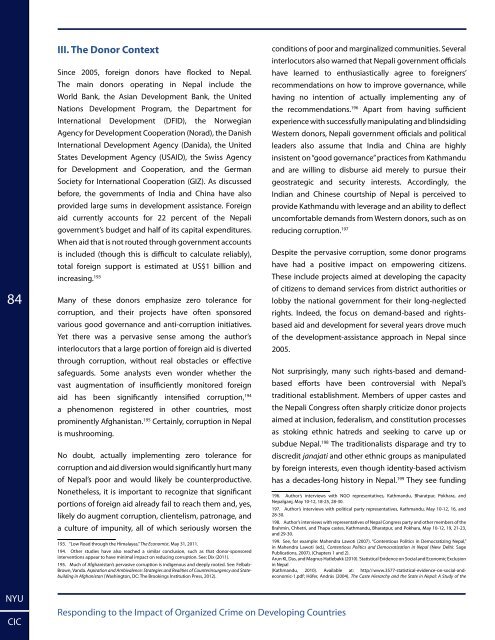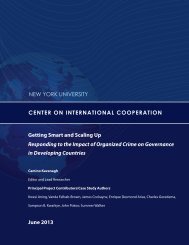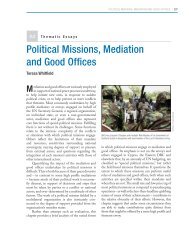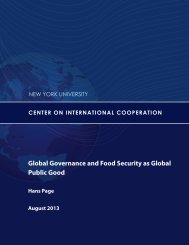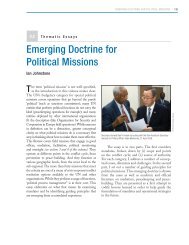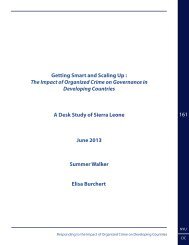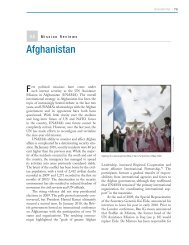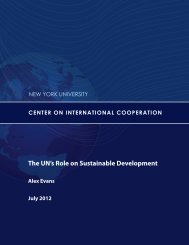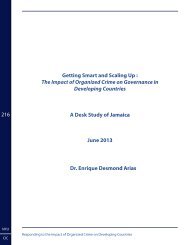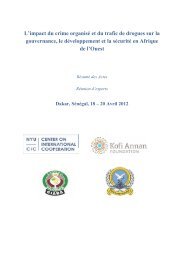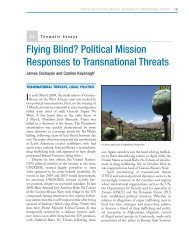here - Center on International Cooperation - New York University
here - Center on International Cooperation - New York University
here - Center on International Cooperation - New York University
You also want an ePaper? Increase the reach of your titles
YUMPU automatically turns print PDFs into web optimized ePapers that Google loves.
84<br />
III. The D<strong>on</strong>or C<strong>on</strong>text<br />
Since 2005, foreign d<strong>on</strong>ors have flocked to Nepal.<br />
The main d<strong>on</strong>ors operating in Nepal include the<br />
World Bank, the Asian Development Bank, the United<br />
Nati<strong>on</strong>s Development Program, the Department for<br />
Internati<strong>on</strong>al Development (DFID), the Norwegian<br />
Agency for Development Cooperati<strong>on</strong> (Norad), the Danish<br />
Internati<strong>on</strong>al Development Agency (Danida), the United<br />
States Development Agency (USAID), the Swiss Agency<br />
for Development and Cooperati<strong>on</strong>, and the German<br />
Society for Internati<strong>on</strong>al Cooperati<strong>on</strong> (GIZ). As discussed<br />
before, the governments of India and China have also<br />
provided large sums in development assistance. Foreign<br />
aid currently accounts for 22 percent of the Nepali<br />
government’s budget and half of its capital expenditures.<br />
When aid that is not routed through government accounts<br />
is included (though this is difficult to calculate reliably),<br />
total foreign support is estimated at US$1 billi<strong>on</strong> and<br />
increasing. 193<br />
Many of these d<strong>on</strong>ors emphasize zero tolerance for<br />
corrupti<strong>on</strong>, and their projects have often sp<strong>on</strong>sored<br />
various good governance and anti-corrupti<strong>on</strong> initiatives.<br />
Yet t<str<strong>on</strong>g>here</str<strong>on</strong>g> was a pervasive sense am<strong>on</strong>g the author’s<br />
interlocutors that a large porti<strong>on</strong> of foreign aid is diverted<br />
through corrupti<strong>on</strong>, without real obstacles or effective<br />
safeguards. Some analysts even w<strong>on</strong>der whether the<br />
vast augmentati<strong>on</strong> of insufficiently m<strong>on</strong>itored foreign<br />
aid has been significantly intensified corrupti<strong>on</strong>, 194<br />
a phenomen<strong>on</strong> registered in other countries, most<br />
prominently Afghanistan. 195 Certainly, corrupti<strong>on</strong> in Nepal<br />
is mushrooming.<br />
No doubt, actually implementing zero tolerance for<br />
corrupti<strong>on</strong> and aid diversi<strong>on</strong> would significantly hurt many<br />
of Nepal’s poor and would likely be counterproductive.<br />
N<strong>on</strong>etheless, it is important to recognize that significant<br />
porti<strong>on</strong>s of foreign aid already fail to reach them and, yes,<br />
likely do augment corrupti<strong>on</strong>, clientelism, patr<strong>on</strong>age, and<br />
a culture of impunity, all of which seriously worsen the<br />
193. “Low Road through the Himalayas,” The Ec<strong>on</strong>omist, May 31, 2011.<br />
194. Other studies have also reached a similar c<strong>on</strong>clusi<strong>on</strong>, such as that d<strong>on</strong>or-sp<strong>on</strong>sored<br />
interventi<strong>on</strong>s appear to have minimal impact <strong>on</strong> reducing corrupti<strong>on</strong>. See: Dix (2011).<br />
195. Much of Afghanistan’s pervasive corrupti<strong>on</strong> is indigenous and deeply rooted. See: Felbab-<br />
Brown, Vanda. Aspirati<strong>on</strong> and Ambivalence: Strategies and Realities of Counterinsurgency and Statebuilding<br />
in Afghanistan (Washingt<strong>on</strong>, DC: The Brookings Instituti<strong>on</strong> Press, 2012).<br />
c<strong>on</strong>diti<strong>on</strong>s of poor and marginalized communities. Several<br />
interlocutors also warned that Nepali government officials<br />
have learned to enthusiastically agree to foreigners’<br />
recommendati<strong>on</strong>s <strong>on</strong> how to improve governance, while<br />
having no intenti<strong>on</strong> of actually implementing any of<br />
the recommendati<strong>on</strong>s. 196 Apart from having sufficient<br />
experience with successfully manipulating and blindsiding<br />
Western d<strong>on</strong>ors, Nepali government officials and political<br />
leaders also assume that India and China are highly<br />
insistent <strong>on</strong> “good governance” practices from Kathmandu<br />
and are willing to disburse aid merely to pursue their<br />
geostrategic and security interests. Accordingly, the<br />
Indian and Chinese courtship of Nepal is perceived to<br />
provide Kathmandu with leverage and an ability to deflect<br />
uncomfortable demands from Western d<strong>on</strong>ors, such as <strong>on</strong><br />
reducing corrupti<strong>on</strong>. 197<br />
Despite the pervasive corrupti<strong>on</strong>, some d<strong>on</strong>or programs<br />
have had a positive impact <strong>on</strong> empowering citizens.<br />
These include projects aimed at developing the capacity<br />
of citizens to demand services from district authorities or<br />
lobby the nati<strong>on</strong>al government for their l<strong>on</strong>g-neglected<br />
rights. Indeed, the focus <strong>on</strong> demand-based and rightsbased<br />
aid and development for several years drove much<br />
of the development-assistance approach in Nepal since<br />
2005.<br />
Not surprisingly, many such rights-based and demandbased<br />
efforts have been c<strong>on</strong>troversial with Nepal’s<br />
traditi<strong>on</strong>al establishment. Members of upper castes and<br />
the Nepali C<strong>on</strong>gress often sharply criticize d<strong>on</strong>or projects<br />
aimed at inclusi<strong>on</strong>, federalism, and c<strong>on</strong>stituti<strong>on</strong> processes<br />
as stoking ethnic hatreds and seeking to carve up or<br />
subdue Nepal. 198 The traditi<strong>on</strong>alists disparage and try to<br />
discredit janajati and other ethnic groups as manipulated<br />
by foreign interests, even though identity-based activism<br />
has a decades-l<strong>on</strong>g history in Nepal. 199 They see funding<br />
196. Author’s interviews with NGO representatives, Kathmandu, Bharatpur, Pokhara, and<br />
Nepalganj, May 10-12, 18-25, 28-30.<br />
197. Author’s interviews with political party representatives, Kathmandu, May 10-12, 16, and<br />
28-30.<br />
198. Author’s interviews with representatives of Nepal C<strong>on</strong>gress party and other members of the<br />
Brahmin, Chhetri, and Thapa castes, Kathmandu, Bharatpur, and Pokhara, May 10-12, 19, 21-23,<br />
and 29-30.<br />
199. See, for example: Mahendra Lawoti (2007). “C<strong>on</strong>tentious Politics in Democratizing Nepal,”<br />
in Mahendra Lawoti (ed.), C<strong>on</strong>tentious Politics and Democratizati<strong>on</strong> in Nepal (<strong>New</strong> Delhi: Sage<br />
Publicati<strong>on</strong>s, 2007). (Chapters 1 and 2).<br />
Arun KL Das, and Magnus Hatlebakk (2010). Statistical Evidence <strong>on</strong> Social and Ec<strong>on</strong>omic Exclusi<strong>on</strong><br />
in Nepal<br />
(Kathmandu, 2010). Available at: http//:www.3577-statistical-evidence-<strong>on</strong>-social-andec<strong>on</strong>omic-1.pdf;<br />
Höfer, András (2004). The Caste Hierarchy and the State in Nepal: A Study of the<br />
NYU<br />
CIC<br />
Resp<strong>on</strong>ding to the Impact of Organized Crime <strong>on</strong> Developing Countries


